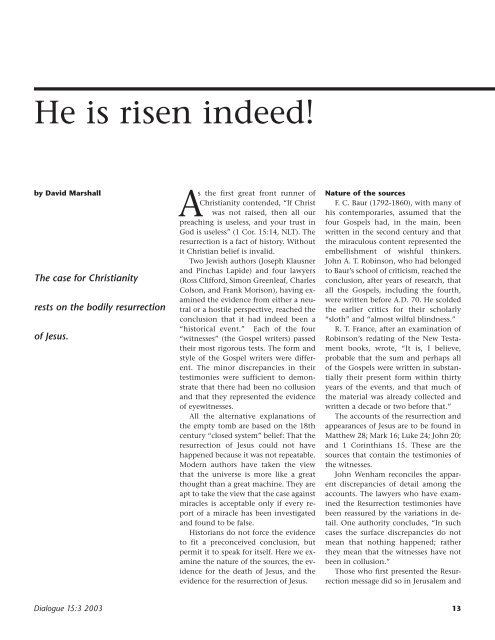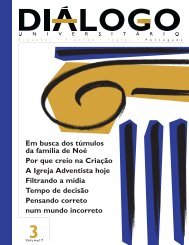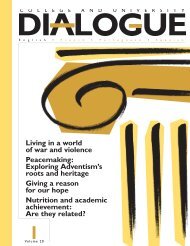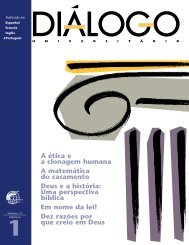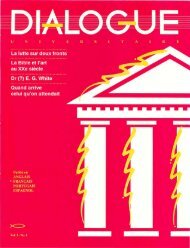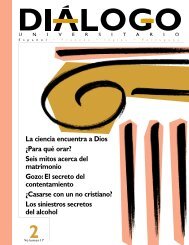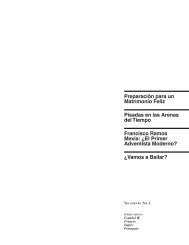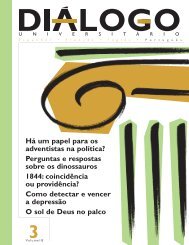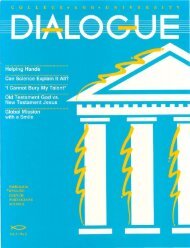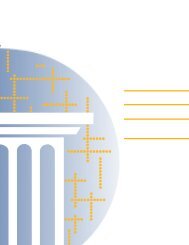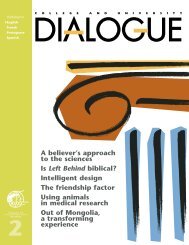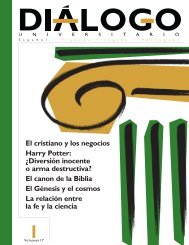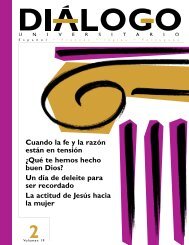Faith, reason, and the educated Christian Creationism - College and ...
Faith, reason, and the educated Christian Creationism - College and ...
Faith, reason, and the educated Christian Creationism - College and ...
Create successful ePaper yourself
Turn your PDF publications into a flip-book with our unique Google optimized e-Paper software.
He is risen indeed!<br />
by David Marshall<br />
The case for <strong>Christian</strong>ity<br />
rests on <strong>the</strong> bodily resurrection<br />
of Jesus.<br />
As <strong>the</strong> first great front runner of<br />
<strong>Christian</strong>ity contended, “If Christ<br />
was not raised, <strong>the</strong>n all our<br />
preaching is useless, <strong>and</strong> your trust in<br />
God is useless” (1 Cor. 15:14, NLT). The<br />
resurrection is a fact of history. Without<br />
it <strong>Christian</strong> belief is invalid.<br />
Two Jewish authors (Joseph Klausner<br />
<strong>and</strong> Pinchas Lapide) <strong>and</strong> four lawyers<br />
(Ross Clifford, Simon Greenleaf, Charles<br />
Colson, <strong>and</strong> Frank Morison), having examined<br />
<strong>the</strong> evidence from ei<strong>the</strong>r a neutral<br />
or a hostile perspective, reached <strong>the</strong><br />
conclusion that it had indeed been a<br />
“historical event.” Each of <strong>the</strong> four<br />
“witnesses” (<strong>the</strong> Gospel writers) passed<br />
<strong>the</strong>ir most rigorous tests. The form <strong>and</strong><br />
style of <strong>the</strong> Gospel writers were different.<br />
The minor discrepancies in <strong>the</strong>ir<br />
testimonies were sufficient to demonstrate<br />
that <strong>the</strong>re had been no collusion<br />
<strong>and</strong> that <strong>the</strong>y represented <strong>the</strong> evidence<br />
of eyewitnesses.<br />
All <strong>the</strong> alternative explanations of<br />
<strong>the</strong> empty tomb are based on <strong>the</strong> 18th<br />
century “closed system” belief: That <strong>the</strong><br />
resurrection of Jesus could not have<br />
happened because it was not repeatable.<br />
Modern authors have taken <strong>the</strong> view<br />
that <strong>the</strong> universe is more like a great<br />
thought than a great machine. They are<br />
apt to take <strong>the</strong> view that <strong>the</strong> case against<br />
miracles is acceptable only if every report<br />
of a miracle has been investigated<br />
<strong>and</strong> found to be false.<br />
Historians do not force <strong>the</strong> evidence<br />
to fit a preconceived conclusion, but<br />
permit it to speak for itself. Here we examine<br />
<strong>the</strong> nature of <strong>the</strong> sources, <strong>the</strong> evidence<br />
for <strong>the</strong> death of Jesus, <strong>and</strong> <strong>the</strong><br />
evidence for <strong>the</strong> resurrection of Jesus.<br />
Nature of <strong>the</strong> sources<br />
F. C. Baur (1792-1860), with many of<br />
his contemporaries, assumed that <strong>the</strong><br />
four Gospels had, in <strong>the</strong> main, been<br />
written in <strong>the</strong> second century <strong>and</strong> that<br />
<strong>the</strong> miraculous content represented <strong>the</strong><br />
embellishment of wishful thinkers.<br />
John A. T. Robinson, who had belonged<br />
to Baur’s school of criticism, reached <strong>the</strong><br />
conclusion, after years of research, that<br />
all <strong>the</strong> Gospels, including <strong>the</strong> fourth,<br />
were written before A.D. 70. He scolded<br />
<strong>the</strong> earlier critics for <strong>the</strong>ir scholarly<br />
“sloth” <strong>and</strong> “almost wilful blindness.”<br />
R. T. France, after an examination of<br />
Robinson’s redating of <strong>the</strong> New Testament<br />
books, wrote, “It is, I believe,<br />
probable that <strong>the</strong> sum <strong>and</strong> perhaps all<br />
of <strong>the</strong> Gospels were written in substantially<br />
<strong>the</strong>ir present form within thirty<br />
years of <strong>the</strong> events, <strong>and</strong> that much of<br />
<strong>the</strong> material was already collected <strong>and</strong><br />
written a decade or two before that.”<br />
The accounts of <strong>the</strong> resurrection <strong>and</strong><br />
appearances of Jesus are to be found in<br />
Mat<strong>the</strong>w 28; Mark 16; Luke 24; John 20;<br />
<strong>and</strong> 1 Corinthians 15. These are <strong>the</strong><br />
sources that contain <strong>the</strong> testimonies of<br />
<strong>the</strong> witnesses.<br />
John Wenham reconciles <strong>the</strong> apparent<br />
discrepancies of detail among <strong>the</strong><br />
accounts. The lawyers who have examined<br />
<strong>the</strong> Resurrection testimonies have<br />
been reassured by <strong>the</strong> variations in detail.<br />
One authority concludes, “In such<br />
cases <strong>the</strong> surface discrepancies do not<br />
mean that nothing happened; ra<strong>the</strong>r<br />
<strong>the</strong>y mean that <strong>the</strong> witnesses have not<br />
been in collusion.”<br />
Those who first presented <strong>the</strong> Resurrection<br />
message did so in Jerusalem <strong>and</strong><br />
Dialogue 15:3 2003<br />
13


